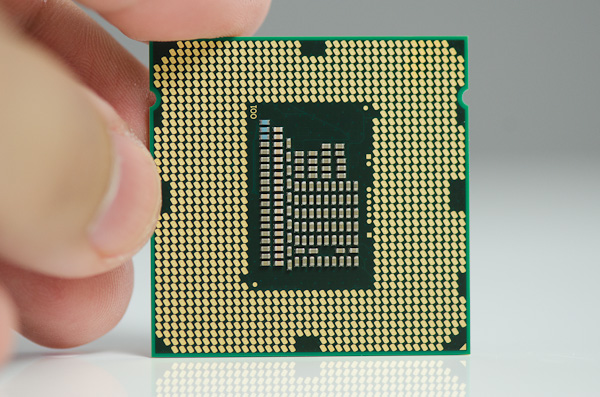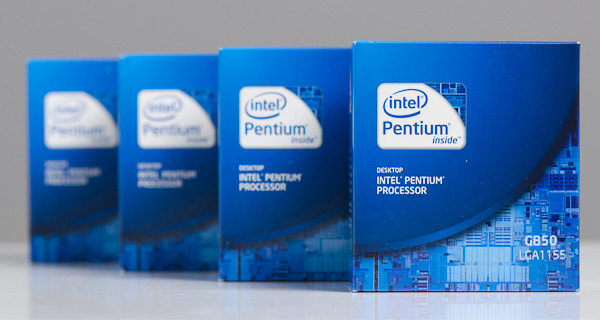The Sandy Bridge Pentium Review: G850, G840, G620 & G620T Tested
by Anand Lal Shimpi on August 23, 2011 12:11 AM ESTIn 2006 Intel introduced its tick-tock cadence for microprocessor releases. Every year would see the release of a new family of microprocessors as either a tick or a tock. Ticks would keep architectures relatively unchanged and focus on transitions to smaller manufacturing technologies, while tocks would keep fab process the same and revamp architecture. Sandy Bridge was the most recent tock, and arguably the biggest one since Intel started down this road.
At a high level the Sandy Bridge CPU architecture looked unchanged from prior iterations. Intel still put forth a 4-issue machine with a similar number of execution resources to prior designs. Looking a bit closer revealed that Intel completely redesigned the out-of-order execution engine in Sandy Bridge, while heavily modifying its front end. Sandy Bridge also introduced Intel's high performance ring bus, allowing access to L3 by all of the cores as well as Intel's new on-die GPU.
The Sandy Bridge GPU was particularly surprising. While it pales in comparison to the performance of the GPU in AMD's Llano, it does represent the first substantial effort by Intel in the GPU space. Alongside the integrated GPU was Intel's first hardware video transcoding engine: Quick Sync. In our initial review we found that Quick Sync was the best way to quickly transcode videos, beating out both AMD and NVIDIA GPU based implementations in our tests. Quick Sync adoption has been limited at best, which is unfortunate given how well the feature performed in our tests.
Sandy Bridge wasn't all rosy however. It was the first architecture that Intel shipped with overclocking disabled on certain parts. Any CPU without Turbo Boost enabled is effectively unoverclockable. Intel killed the low end overclocking market with Sandy Bridge.
The overclocking limits were a shame as Sandy Bridge spanned a wide range of price points. The low end Core i3-2100 was listed at $117 while the highest end Core i7-2600K came in at $317. While you can't claim that Sandy Bridge was overpriced at the high end, there's always room for improvement.
Despite abandoning Pentium as a high end brand with the 2006 release of Intel's Core 2 Duo, Intel has kept the label around for use on its value mainstream parts. Last year we saw only two Pentium branded Clarkdale parts: the G6950 and G6960. This year, powered by Sandy Bridge, the Pentium brand is a bit more active.
| Processor | Core Clock | Cores / Threads | L3 Cache | Max Turbo | Max Overclock Multiplier | TDP | Price |
| Intel Core i7 2600K | 3.4GHz | 4 / 8 | 8MB | 3.8GHz | 57x | 95W | $317 |
| Intel Core i7 2600 | 3.4GHz | 4 / 8 | 8MB | 3.8GHz | 42x | 95W | $294 |
| Intel Core i5 2500K | 3.3GHz | 4 / 4 | 6MB | 3.7GHz | 57x | 95W | $216 |
| Intel Core i5 2500 | 3.3GHz | 4 / 4 | 6MB | 3.7GHz | 41x | 95W | $205 |
| Intel Core i5 2400 | 3.1GHz | 4 / 4 | 6MB | 3.4GHz | 38x | 95W | $184 |
| Intel Core i5 2300 | 2.8GHz | 4 / 4 | 6MB | 3.1GHz | 34x | 95W | $177 |
| Intel Core i3 2120 | 3.3GHz | 2 / 4 | 3MB | N/A | N/A | 65W | $138 |
| Intel Core i3 2100 | 2.93GHz | 2 / 4 | 3MB | N/A | N/A | 65W | $117 |
| Intel Pentium G850 | 2.9GHz | 2 / 2 | 3MB | N/A | N/A | 65W | $86 |
| Intel Pentium G840 | 2.8GHz | 2 / 2 | 3MB | N/A | N/A | 65W | $75 |
| Intel Pentium G620 | 2.6GHz | 2 / 2 | 3MB | N/A | N/A | 65W | $64 |
| Intel Pentium G620T | 2.2GHz | 2 / 2 | 3MB | N/A | N/A | 35W | $70 |
The new Sandy Bridge based Pentiums fall into two lines at present: the G800 and G600. All SNB Pentiums have two cores (HT disabled) with 256KB L2 per core and a 3MB L3 cache. CPU core turbo is disabled across the entire Pentium line. From a performance standpoint, other than missing hyper threading and lower clocks - the Sandy Bridge Pentiums are very similar to Intel's Core i3.
Intel continues to separate the low end from the high end by limiting supported instructions. None of the Pentiums support AES-NI or VT-d. Other than higher clock speeds the 800 series only adds official DDR3-1333 support. The 600 series only officially supports up to DDR3-1066.
All standard Pentiums carry a 65W TDP. The Pentium G620T runs at a meager 2.2GHz and manages a 35W TDP. Regardless of thermal rating, the boxed SNB Pentiums come with an ultra low profile cooler:
These Pentium CPUs work in the same 6-series LGA-1155 motherboards as their Core i3/5/7 counterparts. The same rules apply here as well. If you want video out from the on-die GPU you need either an H-series or a Z-series chipset.
The Pentium GPU
When Intel moved its integrated graphics on-package with Clarkdale it dropped the GMA moniker and started calling it HD Graphics. When it introduced the Sandy Bridge Core i3/5/7, Intel added the 2000 and 3000 suffixes to the HD Graphics brand. With the Sandy Bridge Pentium, Intel has gone back to calling its on-die GPU "HD Graphics".
Despite the name, the Pentium's HD Graphics has nothing in common with Clarkdale's GPU. The GPU is still on-die and it features the same architecture as Intel's HD Graphics 2000 (6 EUs). Performance should be pretty similar as it even shares the same clock speeds as the HD 2000 (850MHz base, 1.1GHz turbo for most models). I ran a quick test to confirm that what Intel is selling as HD Graphics is really no different than the HD Graphics 2000 in 3D performance:

All is well in the world.
Where the vanilla HD Graphics loses is in video features: Quick Sync, InTru 3D (Blu-ray 3D), Intel Insider (DRM support for web streaming of high bitrate HD video) and Clear Video HD (GPU accelerated post processing) are all gone. Thankfully you do still get hardware H.264 video acceleration and fully audio bitstreaming support (including TrueHD/DTS-HD MA).
Missing Quick Sync is a major blow, although as I mentioned earlier I'm very disappointed in the poor support for the feature outside of the initial launch applications. The rest of the features vary in importance. To someone building a basic HTPC, a Sandy Bridge Pentium will do just fine. Personally I never play anything in 3D, never use the Clear Video HD features and never use Intel Insider so I wouldn't notice the difference between a Sandy Bridge Pentium and a Core i5 for video playback.



















110 Comments
View All Comments
yo2020 - Tuesday, August 23, 2011 - link
for both idle and load. :DHavor - Tuesday, August 23, 2011 - link
For anyone that wants to build a low power system, dont look for a 620T or 2100T, they will only cost you actually more money and save's you almost no energy or even cost you extra if you do heavy loads like encoding.After looking up a lot of sites and comparing idle loads i made the following list, and radical changed the dissension on what CPU to use for my server.
CPU (total system use) Idle/Load
E-350 26W /38W
Pentium G620 Undervolt @ 0.9GHz 31W/43W
Pentium G620 31W /60W
Pentium G840 31W /60W
Pentium G850 32W /65W
Core i3 2100 33W /69W
Athlon X2 240e 34W/84W
i3 2120 33W /84W
i5 2400 34W /99W
i5 2500K 34W /110W
i7 2600K 35W /125W
i7-2600K (4.85GHz) 39W/190W
The idle difference between a G620T and a i7 2600K is only 4 watts, and yes under load the 2600K uses 2x the amount of watts, but at the same time it also dose 4x the amount of work, so with the "instruction per watt" (IPW) you are better of with a 2500K/2600K
So now I turn my main system of when i dont need it, and let my server that's 24/7 on anyway, do all the work.
So if a system is needed that needs to do heavy CPU work like encoding, but you still want a energy lean machine, a fast CPU could not be suds a bad idea after all.
Just something to think about ;-)
Marlin1975 - Tuesday, August 23, 2011 - link
These are well suited for HTPC but you did not compare them in that regard?Very few care about synthetic benchmarks, test these for real world uses like HTPC where many are looking to use low-end cpus like these.
Also you can still overclock the intel cpus just not much. Why not overclock the A6/A8 and the intel chips to compare as well?
dubyadubya - Tuesday, August 23, 2011 - link
Seems everyone has forgotten about 64 bit programs. There is zero mention of 64 bit programs in most reviews on the net. Testing using mainly 32 bit programs and not stating which programs are 32/64 bit give the impression that Intel's SB is way faster than AMD's offerings. AMD offerings perform much better running 64 bit code than Intel's SB so lets see some multi-threaded 64 bit testing.Traciatim - Tuesday, August 23, 2011 - link
Benchmark links?A5 - Tuesday, August 23, 2011 - link
You're going to have to back that up.silverblue - Tuesday, August 23, 2011 - link
Either you're saying that AMD's CPUs perform better in 64-bit mode than 32-bit mode, or that AMD's CPUs are better at x86-84 than Sandy Bridge. Regardless, as stated, you'll need to provide some evidence to back this up.AngryMonkeyMob - Tuesday, August 23, 2011 - link
While it is true that AMD can keep competitive on price/performance, when it comes to power consumption AMD gets it the hot bullets of shotgun when compared to Intels baked goods. That matters to some people ( it does to me ). I'd use this in a tiny ITX machine with something like this http://www.logicsupply.com/products/ga620ibk_a1...But I'd imagine that makes me a minority around here :)
Death666Angel - Friday, August 26, 2011 - link
If you do something that specific, surely you know how to undervolt a CPU? :-) AMDs Llano can be undervolted quite heavily as far as I know and the 65W TDP chips (A8-3800 and A6-3600 afaik) will already perform much more energy conscious out of the box. :-)CeriseCogburn - Monday, June 25, 2012 - link
Since you quibble on 5 or 20 bucks when it comes to a crap apu, and spend minimum $124.00+ on a tiny computer case, yes, I'd say, God Willing, you are in the minority around here, but I fear, that you definitely are not.Oh the irony